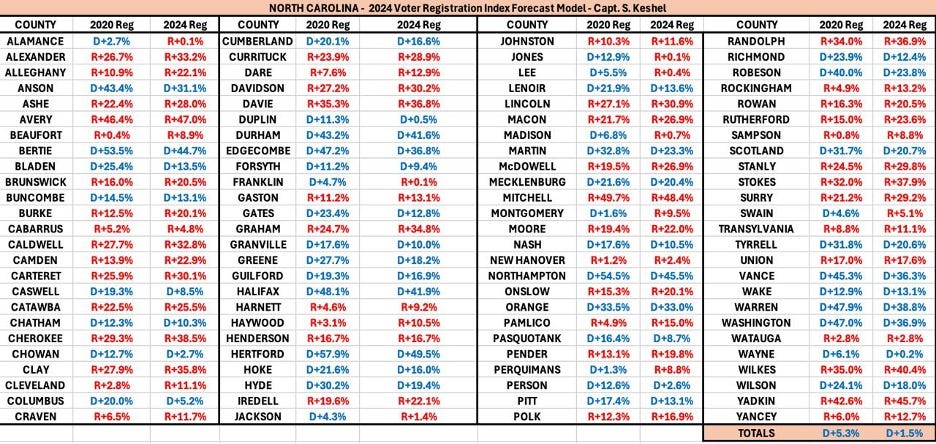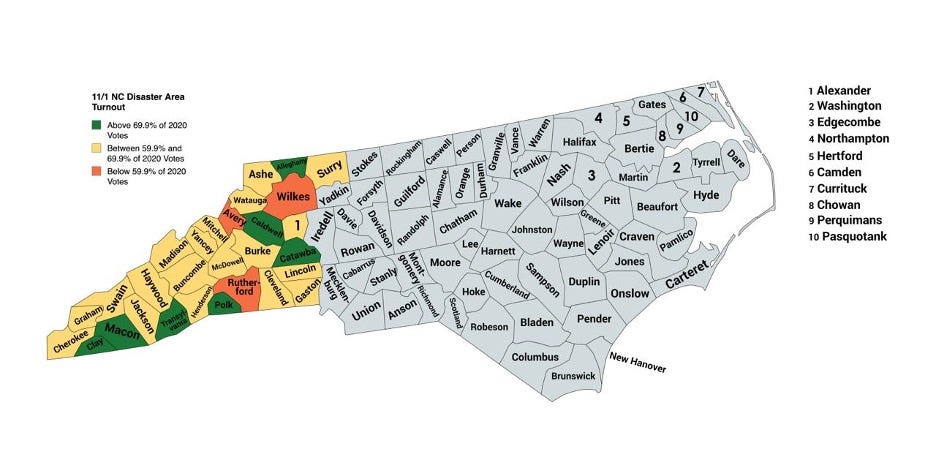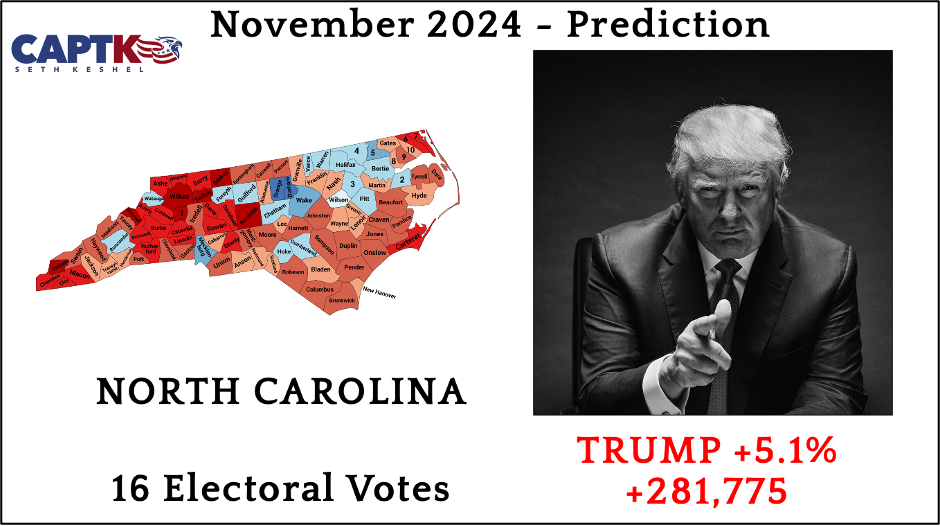November 1, 2024
My first final prediction for the eight battleground states of 2024 is for North Carolina.
I have had the state as a “leaner” for the entirety of the cycle, likely to go for Donald Trump by a margin inside ten points. I previewed it in July and ballparked a 4-6% Trump win, but thanks to the continued focus of both campaigns on the state, I have gone further into analysis just as I have with the states I consider the “seven decisive states.”
Party Registration
2020 – D+5.3% (D+391,414)
2024 – D+1.4% (D+110,490)
Net Shift – R+3.9% (R+280,924)
Party registration presents an ugly picture for Democrats, with 96 of 100 counties more Republican or less Democrat than they were in 2020, when Trump still won the state despite the conditions of the 2020 quasi-election with rampant mail-in balloting abuse and before the state adopted Voter I.D. requirements. This represents a continued collapse for Democrats present since 2008.
What Harris Must Do to Win
Harris is fundamentally the underdog in North Carolina, a state Trump has won twice and one that shows an increasingly Republican registration trend almost everywhere. I analyzed the Democrat window of opportunity earlier this year and found that Joe Biden, the presumptive nominee at the time, was unlikely to have a ceiling higher than 30,000 votes (less than a point) in victory margin if and only if everything went his way. The same equation remains for Kamala Harris.
For this to come true, Harris would need blowout margins in Wake (metro Raleigh) and Mecklenburg (metro Charlotte) Counties, sustained dominance in the Research Triangle, and sagging Trump margins in the outlying counties, which are overwhelmingly Trump-trending. There was a window for this narrative to take root in September after Hurricane Helene, but that has closed now that the 29 counties west of the flood line are almost all turning out near or above the current 69.9% share of 2020’s turnout observed statewide:
To further complicate things for Harris, Mecklenburg County is 200,567 votes off its total 2020 turnout with just today’s early vote and Election Day remaining to equal it, with Wake County lagging even further back, 229,187 off. This is almost certainly due to flaccid urban turnout, especially among black men, a fact much to the chagrin of the state’s Democrat leadership. 16 of 19 counties over the 69.9% statewide turnout mark are Trump-won counties from 2020.
What Trump Must Do to Win
Trump simply has to go with the flow. Republicans lead the early vote for the first time in history, with a lead of over 50,000 ballots as of this morning. 96 counties are poised to have better Trump outcomes than they did in 2020 based on registration trend alone, and it is widely expected he will accelerate his progression with the state’s black voters, which have collectively sagged below 20% in overall turnout. Trump is playing North Carolina safe this year and has several more rallies there to ensure that it doesn’t get Georgia’d. Holding it keeps him at his “Core 235” electoral vote base camp and needing just Georgia and Pennsylvania to punch out along the shortest path to a majority.
Models
My pessimistic trend forecast of North Carolina gives Trump a win of roughly 1.4% in the worst case scenario. Based on the current status of the race, I think this is too low.
My registration analysis of North Carolina, which I did not publish as a separate piece, is too bullish for Trump when calculated at the state level, and this is owed to the stagnation of margin shifts as the state reclassifies its party registration data. Registration data for urban counties are more clearly predictive than that of outlying areas that have long voted Republican, and when I analyzed party registration for all 100 counties, I came up with the following chart for margin trajectory:
This model suggests a Trump victory of 6.3%, or 350,344 votes, with progression in the standard Republican-trending areas, and most importantly, smaller margins for Harris than Biden had in key urban counties like Mecklenburg, Wake, Durham, Buncombe, and Guilford Counties.
Final Call
I believe the registration model, combined with party registration data, is a more likely destination for this election than the pessimistic model:
Pessimistic Model - Trump +1.4%
Registration Model - Trump +6.3%
These average out to Trump +3.9%, and splitting the difference between the average and the registration model brings me to:
Donald Trump +5.1% (+281,775)
Likely County Flips:
Anson
Pasquotank
Seth Keshel, MBA, is a former Army Captain of Military Intelligence and Afghanistan veteran. His analytical method of election forecasting and analytics is known worldwide, and he has been commended by President Donald J. Trump for his work in the field.










Watching nervously from the UK. We will send our sons to die along with yours in the next pointless war, hence why it matters to us that Trump is elected and not Kamala and her new chickenhawk bestie. Fingers and toes crossed for you.
Not believing any pollster that has Harris +1 in NC.